

Steam and gas desuperheaters
The effectiveness of a desuperheating process depends on the correct amount of water introduced into the steam and the quality of its atomization.

Steam and gas desuperheaters
The effectiveness of a desuperheating process depends on the correct amount of water introduced into the steam and the quality of its atomization. Water is injected into the steam in the form of very small droplets (spray) generated by mechanical atomization in the spray nozzles. The heat transfer is very fast, so the droplets evaporate quickly, cooling the steam and avoiding water accumulation in the line.
ADVANTAGES:
- Temperature control in industrial processes
- Savings in energy consumption and consequently, reduction in operating costs
- Safety in critical processes, prevention of overheating risks
- Wide applicability, adaptable to different process needs
- Reduction of cycle times
- Greater efficiency of industrial processes
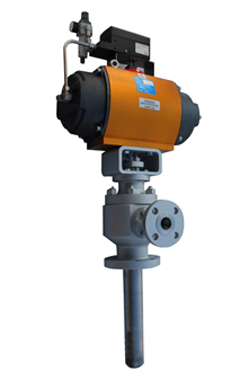
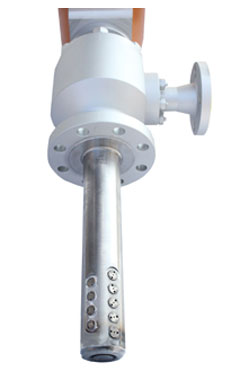
APPLICATIONS:
- Steam saturation to heat exchangers or heating jackets
- Drying drums
- Steam to molding or vulcanized equipment
- Boilers
- Desuperheating after steam turbine
- Saturation and/or cooling of gases or vapors

Types of Desuperheaters
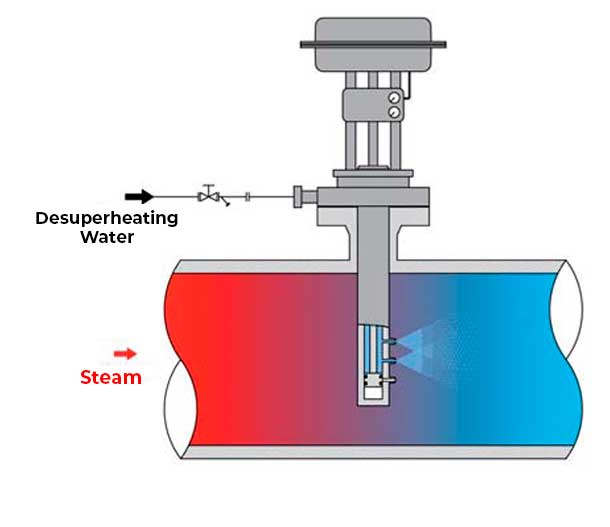
- It consists of: radial injection body + separate control valve.
- Excellent atomization and water-steam mixing by injection perpendicular to the direction of steam flow in an area of high turbulence (venturi).
- The volume of water to be injected is regulated by a separate control valve, using a standard control loop.
- Mounted on steam pipe up to 4” wafer between flanges or with ends for welding.
Designed for stable steam flow rates and pressures and medium-low pressure services in diameters up to 4”.
Also for applications where a minimum tempering water flow rate is required (Optional up to 8”).
 It consists of: injection pipe with fixed nozzles + separate control valve.
It consists of: injection pipe with fixed nozzles + separate control valve.- Mechanical atomization desuperheating system with high efficiency fixed nozzles (always open) for a wide range of steam and water flow rates.
- The volume of water to be injected is regulated by a control valve, using a standard control loop.
- Mounting on steam pipe from 6” to 48” using a 3” or 4” flanged insert.
Designed for stable steam flow rates and medium-high pressure services in diameters from 6”.
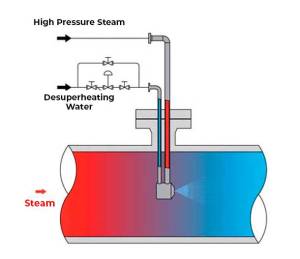
- It consists of: water injection pipe, steam injection pipe, dual nozzle + separate control valve.
- Mechanical desuperheating with fixed dual nozzle (always open) where the tempering water is mixed with high pressure and high speed steam (jet inyector) creating great turbulence and very small water droplets, at the moment prior to its injection into the steam pipe.
- The volume of water to be injected is regulated by a separate control valve, using a standard control loop.
- The high presure assisted steam line is controlled by an On-Off valve, sonnected to the DCS of the plant.
- Mounting on steam pipe from 6” to 48” using a 3” or 4” flanged insert.
Diseñado para caudales de vapor variables y para bajas velocidades o cuando el porcentaje de agua/vapor es superior al 20%.
HIGH RANGEABILITY
The “motive steam” system improves the transfer of energy from steam to water. The evaporation and absorption of water by steam is more effective creating high amount of water droplets and so larger contact surface..
The process can be set very close to the saturation temperature.
The temperature sensor can be located at a distance less than that required in another type of desuperheater.
Excess of injected water is reduced to a minimum.

- It consists of: injection pipe with variable nozzles, actuator and positioner.
- The regulation of the water flow is carried out by the desuperheater itself by processing the signal from a standard control loop.
- No separate control valve required.
- Mechanical temperature control with variable nozzles. The volume of injection water is controlled by the number of open nozzles. Depending on the signal received, the actuator moves the stem opening/closing the nozzles depending on the amount of water needed.
- Mounting on steam pipe from 6” to 48” using a 3” or 4” flanged insert.
Designed for variable steam flow rates with cases of low speeds and/or low water flows. Optimum temperature throughout the range.
HIGH RANGEABILITY.
In the integrated desuperheater, the water pressure is constant inside the injection lance, regardless of the amount of water required. The ΔP between water and steam is constant and therefore atomization is always at the proper condition.
In the previous options, low water volume demands may cause a choke in the control valve and the pressure available in the nozzles will be less than optimal for correct atomization.
The actuator can be pneumatic, electric or hydraulic.
The integrated desuperheater combines precision in the amount of water to be injected through the progressive opening of nozzles with the availability of constant water pressure throughout the range for adequate atomization.
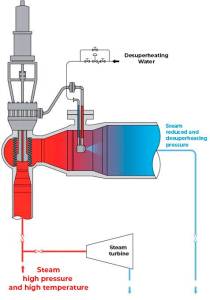
A common application in steam generation plants consists of conditioning them through a combined pressure and desuperheating reduction system, as occurs with turbine by-pass valves.
By way of introduction, we indicate that UNITECNO has a complete program of steam conditioning stations (rIntegrated control valve an desuperheating systeam):
Range: Entry 3″ to 20″
Outlet 4″ to 64″
Rating: 150# to 4500#
Compliance with ANSI or DIN/EN regulations.
In combination with electrohydraulic actuation it complies with the safety standard DIN EN ISO 4126-5 for protection against in-line overpressure, according to TRD 421.
Therefore, the station performs the following functions:
- Steam converting: Reduction of steam pressure and temperature.
- Boiler safety valve. With this arrangement, the regulatory spring-loaded safety valves in the boiler are not necessary.
- Steam tubine by pass
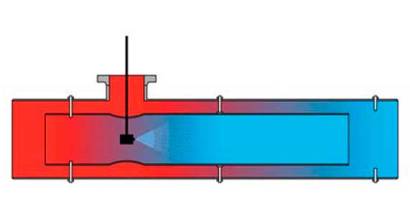
- Control valves for water desuperheating line.
- Desuperheating pipes/spools/silencers.
- Desuperheating pipes with protective jacket (thermal shock protective pipe).
- Discharge duct (dump tube).
- Isolation valve and protective filter.
Isolation valve and protective filter.
In those cases in which the desuperheating difference between the superheated steam and the tempering water exceeds 200ºC (ΔT200ºC) there is a risk of damage to the pipe due to thermal shock.>
1. Protection of the main steam pipe against cracking or breaking due to thermal stress or the impact of water drops not yet evaporated.
2. Optimization of the desuperheating process by increasing speed and so creating greater turbulence. It produces a more progressive temperature exchange in the area external to the jacket.
Desuperheaters
NOTES AND RECOMMENDATIONS:
The closer the water temperature is to the saturation temperature of the steam to be cooled better desuperheating will be.
- When service conditions indicate a risk of thermal shock due to high ΔT (steam-water), the use of a thermal shock protective pipe is recommended.
- The minimum recommended addition water pressure is 5 bar above the pressure of the steam to be cooled.
The steam outlet temperature must be at least 5ºC higher than the saturation temperature. - For percentages of water flow over steam WATER/STEAM RATIO exceeding 20%, it is recommended to use the desuperheater with assisted steam (motive steam).
- The straight distance after tempering should be greater than 15 times the diameter of the steam pipe, with a minimum of 4 meters. This distance can be reduced with the motive steam system and the integrated desuperheater.
- The steam pipe after should have a slope of 2% and have a trap with a capacity of 10% of the maximum water flow.
- The water control valve and desuperheater should be located as close as possible. The control valve should be located below the tdesuperheating.
- The addition water pipe, steam pipe and desuperheater must be thermally insulated.
- In the water pipe, before the desuperheater, a filter with a 0.25mm mesh must be installed.
- The screws that hold the desuperheater flanges are subject to sudden changes in temperature. It is recommended to use high-strength screws and nuts.
- Arrangement of temperature probes:

- Distance to temperature sensor.
If the distance coincides with one elbow, it is recommended to move the sensor two meters lower.

